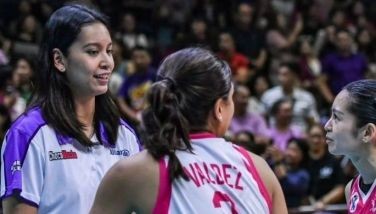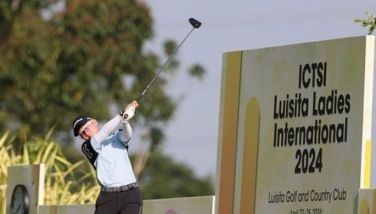Getting strict on landing spot rule
PBA commissioner Chito Narvasa is making sure players are aware of the gravity of contact on the landing spot by recently issuing a fresh memorandum calling attention to the commission of flagrant fouls with particular mention of the rule. Narvasa says it’s not just to protect a shooter who’s airborne but also any player in mid-air whether he’s in the act of shooting or passing or rebounding or defending or whatever. The consideration is a player must be off his feet.
No doubt, contact on the landing spot is dangerous and could lead to serious injury. In the ongoing Governors Cup, players who’ve been whistled for this infraction were James White on Sol Mercado, A. J. Mandani on Jimmy Alapag, Maverick Ahanmisi on Arwind Santos, Kris Rosales on Mahmoud Abdeen, Jason Forte on Henry Walker, Allen Durham on Jericho Cruz and Jewel Ponferada on Aldrech Ramos and Mark Yee. Each player paid a fine of P7,500 for the flagrant foul. Ponferada coughed up P17,500 for his two fouls.
Clarifying the rule, Narvasa explains that “a defender who lunges forward and lands more than half a foot from his take-off point and the shooter lands on the defender’s foot, a flagrant foul penalty 1 is called…if the shooter is injured and has to be substituted, the penalty 1 will be upgraded to penalty 2.” Narvasa says an airborne player must be given the chance or space to land safely and the landing spot rule is applicable not only on a shooting situation but also during passing, rebounding and jumpball situations.
With the quarterfinal playoffs starting tomorrow, Narvasa is reminding players that dangerous fouls won’t be tolerated. He says referees will also be strict in calling third party contact where a player makes illegal contact with another player who then makes illegal contact with another player. In this case, a player could push an opposing player to make illegal contact with his teammate. “If such illegal contact results in a landing spot infraction, the player who causes or initiates the contact will be penalized,” says Narvasa. So there’s no escaping the rule.
Narvasa says there will be no adjustments in officiating standards during the conference. “Not while the conference is going on,” he says. “And even in the finals, the officiating standards will remain the same.” However, Narvasa says change is coming next season as the league looks forward to aligning its officiating philosophy with FIBA standards in anticipation of more international competitions involving PBA players with Gilas.
Narvasa says the only exception is a slight tweak in the rule on a lane violation off a missed free throw. Starting tomorrow, he says the PBA will revert to the previous rule of allowing the rebounders closest to the basket and the defending player to screen off the shooter to move inside the lane upon the release of the ball. Players situated in the perimeter and the shooter will not be allowed to enter the lane until the ball hits the rim. This season, the PBA made it a uniform rule that no player may enter the lane until the ball hits the hoop but Eric Castro of the technical committee says after review, the decision was to return to the previous rule which encourages a quicker transition.
Castro says the PBA now has a grading system for referees where in every game, he or she is monitored in terms of correct, wrong and missed calls. A percentage rating is computed where the number of correct calls is divided by the number of wrong and missed calls. Castro says a referee makes an average of 14 to 18 calls a game. The grades have been in the range of 83 to 94 percent.
“We splice all the calls and put them in a video so we’re able to review closely each of every referee’s calls,” says Castro. This will then be a basis for evaluating a referee’s performance. Narvasa says the system isn’t foolproof. For instance, in a game, a referee may make 14 correct calls but on the 15th, he falters and his error decides the outcome. Obviously, the referee’s grade will be high based on the formula for rating but he’ll be singled out for that game-changing mistake. Narvasa says the grading system establishes a benchmark for consistency and ability.
The pool of referees was recently cut from 16 to 15. Castro says it’s possible only some of the referees may be tapped to work the semifinals and finals. In the previous conference, only 10 referees were designated to officiate in the finals.
- Latest
- Trending






























